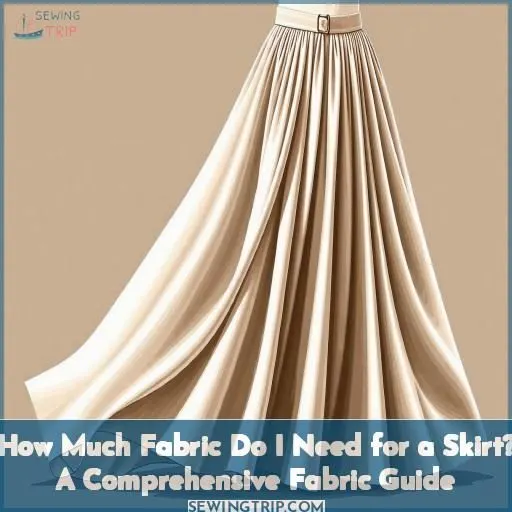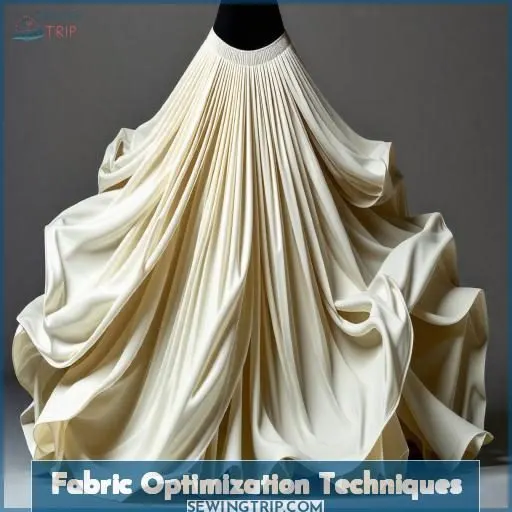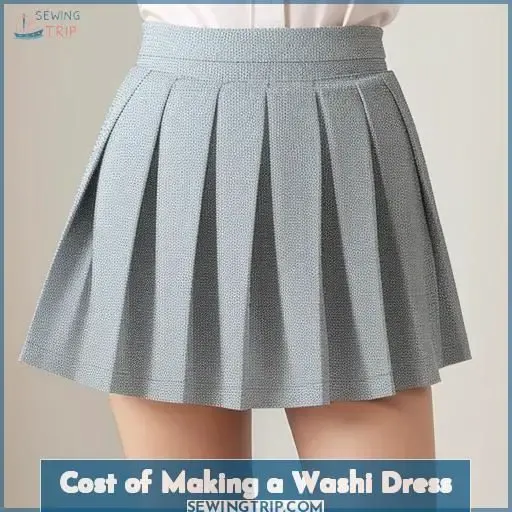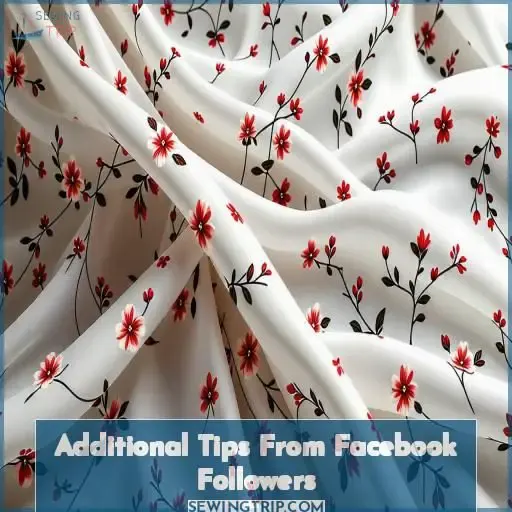This site is supported by our readers. We may earn a commission, at no cost to you, if you purchase through links.
 To determine how much fabric you need for a skirt, you’ll generally require:
To determine how much fabric you need for a skirt, you’ll generally require:
1-2 yards for straight skirts.
1.5-2.25 yards for A-line skirts.
However, fabric width is essential:
Narrower fabrics like 35-inch widths necessitate more yardage (2.25-3.25 yards).
Wider 52-54 inch fabrics require less yardage (1.25-2.25 yards).
Additionally, account for pattern direction:
Add 0.25 yards per yard for napped fabrics.
Add one pattern repeat per yard for plaids.
Optimizing fabric usage through patterns designed for efficient cutting can further minimize material needs.
With this guidance on fabric requirements, you’re primed to explore the nuances that transform a skirt into a personalized masterpiece.
Table Of Contents
Key Takeaways
- The fabric requirements for a skirt depend on the style, with straight skirts needing 1-1/4 to 2 yards and A-line skirts requiring 1-1/2 to 2-1/4 yards.
- Fabric width is crucial, as narrower 35-36 inch fabrics need more yardage (2-1/4 to 3-1/4 yards) compared to wider 52-54 inch fabrics (1-1/4 to 2-1/4 yards).
- Adjustments must be made for fabrics with nap or one-way designs, adding 1/4 yard per yard for nap and one pattern repeat per yard for plaids.
- Techniques like utilizing spaghetti straps, capes, and efficient pattern layouts can help maximize fabric usage and reduce overall material needs.
How Much Fabric Do I Need for a Skirt?
When determining fabric requirements for a skirt, consider the style and design. Straight skirts typically require 1-1/4 to 2 yards of fabric, while A-line skirts need 1-1/2 to 2-1/4 yards.
Fabric Requirements for Skirts
When sewing a skirt, the fabric requirements depend on the skirt length and style. For a straight skirt, you’ll need 1-1/4 to 2 yards of fabric. For an A-line skirt, the range is 1-1/2 to 2-1/4 yards. Consider the fabric width, any nap or one-way designs, and whether the skirt is bias cut or pleated.
Straight Skirts
To determine how much fabric you need for a straight skirt, consider the fabric length based on the style.
The typical range for a straight skirt is 1-1/4 to 2 yards, depending on the desired length and size.
Be sure to take into account the fabric width, type, and potential pattern selection to accurately estimate how many yards you require to make your skirt.
A-Line Skirts
For an A-line skirt, you’ll typically need 1-1/2 to 2-1/4 yards of fabric. Look for sturdy, high-cotton content fabrics that provide structure, like cotton twill or linen. Embellish your A-line with pleats, pockets, or a paperbag waist. Choose patterns that flatter your figure, like Simplicity 1419 or Butterick 6244.
- A-line skirt length: 1-1/2 to 2-1/4 yards
- Fabric types: Cotton twill, linen
- Embellishments: Pleats, pockets, paperbag waist
- Pattern selection: Simplicity 1419, Butterick 6244
- Sewing tips: Gather fabric for a flattering silhouette
Fabric Width Considerations
When selecting fabric for your skirt, consider the width carefully. Narrower 35-36 inch fabrics require 2-1/4 to 3-1/4 yards, while wider 52-54 inch fabrics need only 1-1/4 to 2-1/4 yards. For a summer skirt, lightweight cotton or voile in vibrant prints or solid colors are excellent choices. Pay attention to the pattern repeat when using wider fabrics.
Adjustments for Nap and One-Way Designs
When working with fabrics that have a nap or one-way designs, be sure to:
- Add 1/4 yard for each yard specified to account for the nap direction.
- For plaids, add the length of one plaid repeat for each yard specified to guarantee pattern matching.
- Consider the fabric weight and grain line when cutting bias-cut skirts to maximize the drape and flow of the material.
Fabric Optimization Techniques
To maximize fabric usage, consider designs like spaghetti straps and capes. When working with 45-inch cotton, opt for structured garments like A-line skirts; for wider fabrics, pay attention to pattern repeats and layout.
Maximize Fabric Usage
To maximize fabric usage, consider using spaghetti straps, crafting capes from coating/jacketing fabric, and making straight, pencil, or A-line skirts with just 1 meter of fabric. Shorter semi-circle skirts can also be created with 1 meter. Utilize patterns like Simplicity 4070, Simplicity Cynthia Rowley 2178, Lisette 2059, Lisette 2060, and Simplicity Cynthia Rowley 1873 for efficient fabric usage.
Working With 45-Inch Cotton
When working with 45-inch cotton, consider patterns that need more structure or body. Create flattering A-line skirts with this versatile fabric. Look for patterns like Serendipity Studio 123 – Bebe Dress and Burda Style Jenny Variation C. Explore the wide range of colors and prints available in 45-inch cotton to add visual interest to your garments.
- Utilize 45-inch cotton for structured skirts
- Opt for A-line silhouettes to flatter your figure
- Discover patterns that showcase the fabric’s qualities
- Experiment with the diverse color and print options
Using Wider Cottons
When using wider cottons, you’ll need less meterage overall. However, be mindful of the pattern repeat – purchase extra fabric for defined patterns to guarantee enough repeat. Refer to Sewing Machine Success for tips on buying different fabric types, and use your best judgment when laying out pattern pieces on wider fabrics.
- Consider pattern repeat when using wider fabrics.
- Purchase extra fabric for defined patterns to guarantee enough pattern repeat.
- Refer to Sewing Machine Success for tips on buying different fabric types.
- Use judgment and consider pattern piece layout when using wider fabrics.
Cost of Making a Washi Dress
Regarding the cost of crafting a Washi Dress, the fabric expenditure can be fairly reasonable. Employing Croft Mill poplin, the fabric cost for an XS to Medium-sized dress is merely £17.37. To further optimize your fabric consumption and costs, contemplate utilizing broader plain or less well-defined pattern fabrics. This can aid in reducing the overall yardage necessary. Pay attention to the pattern repeat when working with wider fabrics, and acquire additional material if required to guarantee adequate coverage. Ultimately, the total fabric cost for a complete Washi Dress ensemble can be less than £18.00, rendering it an attainable and budget-conscious sewing project.
- Fabric cost for an XS – Medium Washi Dress: £17.37
- Use wider fabrics to reduce yardage required
- Total fabric cost for a complete Washi Dress outfit: less than £18.00
Additional Tips From Facebook Followers
As you continue your sewing journey, don’t forget to tap into the wealth of knowledge shared by fellow sewists on Facebook.
The Croft Mill Facebook page, for instance, is a treasure trove of tips and tricks.
Craft sun hats, gift bags, and even baby panties using those leftover fabric scraps.
And in regard to patterns, consider exploring options like Simplicity 2346, New Look 6838 top, and Burda 8347.
Don’t be afraid to get creative – you can even download the free Polly Top pattern from By Hand London and add your own unique flair.
Frequently Asked Questions (FAQs)
How much cloth is required for a skirt?
You’ll need between 1-1/4 to 2 yards of fabric for a knee-length, straight skirt. But for a flowy, floor-length stunner, grab around 3 yards. Easy, right? Now let’s make that dream skirt a reality!
How many yards of fabric are needed for a skirt?
Casting an eye to the pattern, you’ll need 2-3 yards of fabric for a knee-length skirt—the exact yardage depending on width.
Can I make a skirt with 2 yards of fabric?
You can absolutely make a skirt with 2 yards of fabric. That yardage works well for knee-length and shorter styles like A-line or pencil skirts.
Can you make a skirt with 1 yard?
Yes, you can make a knee-length, flared skirt with 1 yard of fabric. Start with a circle skirt pattern and follow the instructions carefully to maximize fabric use.
What are the best fabrics for skirt-making?
The best fabrics? You’ll want sturdy, non-stretch materials like cotton, linen, or denim. Fabrics with a crisp hand and body will give your skirt great structure and shape. Pro tip: Higher cotton content equals more longevity for your new garment.
How do I choose the right skirt pattern?
Regarding skirt patterns, avoid improvising – select one that conforms to your body like a second skin. Take into account style, silhouette, and construction simplicity to guarantee a skirt you’ll adore wearing.
What are some tips for fitting a skirt properly?
For a proper fit, you’ll want to take accurate body measurements, select the right size pattern, and make adjustments during the fitting process. Baste the skirt before final sewing to make sure a flattering drape and perfect fit around your curves.
How can I add unique details to my skirt?
Add unique details like pockets, ruffles, embroidery, or patterned fabric to make your skirt stand out. Get creative with trims, lace, or decorative buttons for an eye-catching touch.
What are the common challenges in skirt construction?
One challenge is achieving a smooth drape and fit around your waist and hips. Another is inserting closures like zippers invisibly. Proper pattern layout maximizes fabric usage and maintains print directionality.
Conclusion
Ultimately, figuring out how much fabric you need for a skirt requires considering the style, width, and unique characteristics of the fabric itself.
By taking into account aspects like nap direction and pattern repeats, you’ll ensure a perfect drape and smooth design execution.
With this complete guide, you’re equipped to calculate the exact fabric requirements, paving the way for a skirt that reflects your personal style and creative vision.









